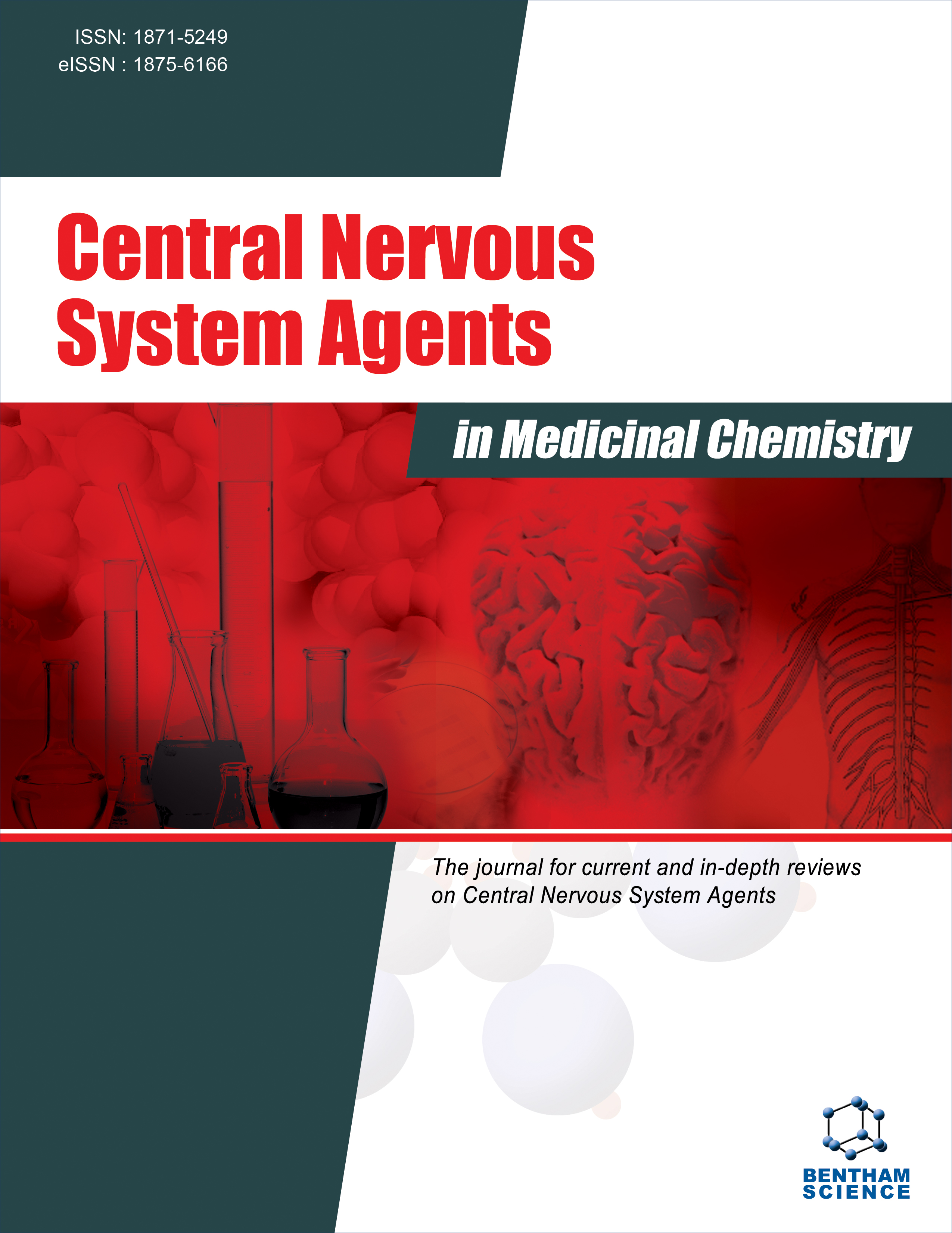- Home
- A-Z Publications
- Central Nervous System Agents in Medicinal Chemistry (Formerly Current Medicinal Chemistry - Central Nervous System Agents)
- Previous Issues
- Volume 12, Issue 4, 2012
Central Nervous System Agents in Medicinal Chemistry (Formerly Current Medicinal Chemistry - Central Nervous System Agents) - Volume 12, Issue 4, 2012
Volume 12, Issue 4, 2012
-
-
Targeting to 5-HT1F Receptor Subtype for Migraine Treatment: Lessons from the Past, Implications for the Future
More LessAuthors: Dimos D. Mitsikostas and Peer Tfelt-HansenThe effective anti-migraine drugs triptans, all bind with high affinity to three serotonin (5-HT) subtypes, the 5-HT1B, 5-HT1D and 5-HT1F. 5-HT1B mRNA is densely localized within smooth muscle, and less in the endothelium of cerebral blood vessels. This vascular distribution of 5-HT1B receptor has been shown to mediate the vasoconstrictive properties of the triptans, responsible for potential cardiac adverse events. Ac Read More
-
-
-
Genetics in Neural Toxicities of Drugs
More LessAuthors: Da-Yong Lu, Ting-Ren Lu and Peng-Peng ZhuAdverse side effects or toxicities of a drug were previously regarded as a manifestation of drug's own characterizations, such as the chemical structure and property of a drug. More recently, increasing experimental or clinical data and modern ideas suggest that human's genetic factors also play indispensable roles in resulting neural side effects of a drug, especially in antidepressant-induced suicide and antibiotics-induce Read More
-
-
-
Synthesis and Pharmacological Evaluation of Novel 4-Alkyl-5-thien-2'-yl Pyrazole Carboxamides
More LessThe synthesis of three series of novel 4-alkyl-5-(5'-chlorothiophen-2'-yl)-pyrazole-3-carbamoyl analogues of rimonabant with affinity for the CB1 cannabinoid receptor subtype is reported. Amongst the novel derivatives, compounds 21j, 22a, 22c, and 22f showed affinity values expressed as Ki ranging from 5.5 to 9.0 nM. Derivative 23e revealed a good CB1 affinity (Ki = 11.7 nM) and the highest CB1 selectivity of the whole serie Read More
-
-
-
Viral Encephalitis: Current Treatments and Future Perspectives
More LessSeveral viruses may cause central nervous system infections that lead to a broad range of clinical manifestations. The course of the viral encephalitis can be acute, sub acute, or chronic. Some viruses have the ability to enter into the brain and cause direct injury, while others activate inflammatory cells that attack the central nervous system (CNS) secondarily. Some types of viral encephalitis occur in previously healthy Read More
-
-
-
Vasopressin in Health and Disease with a Focus on Affective Disorders
More LessBy Dora ZelenaThe therapies of mood and anxiety disorders are not solved, because current antidepressants have delayed onset of therapeutic action and a significant number of patients are non-responsive. Research on the field was leaning towards neuropeptides as therapeutic targets. Vasopressin (VP) is a hot candidate, as beyond its peripheral actions VP is implicated in interneuronal communication and modulates the hypothalam Read More
-
-
-
Elucidation of Pathophysiology and Treatment of Neuropathic Pain
More LessNeuropathic pain, pain arising as a direct consequence of a lesion or disease affecting the somatosensory system, is relatively common, occurring in about 1% of the population. Studies in animal models describe a number of peripheral and central pathophysiological processes after nerve injury that would be the basis of underlying neuropathic pain mechanism. Additionally, neuro-imaging (positron emission tomography an Read More
-
-
-
Effects of Snake Venom Polypeptides on Central Nervous System
More LessAuthors: Alexey Osipov and Yuri UtkinThe nervous system is a primary target for animal venoms as the impairment of its function results in the fast and efficient immobilization or death of a prey. There are numerous evidences about effects of crude snake venoms or isolated toxins on peripheral nervous system. However, the data on their interactions with the central nervous system (CNS) are not abundant, as the blood-brain barrier (BBB) impedes penetration of t Read More
-
Volumes & issues
-
Volume 25 (2025)
-
Volume 24 (2024)
-
Volume 23 (2023)
-
Volume 22 (2022)
-
Volume 21 (2021)
-
Volume 20 (2020)
-
Volume 19 (2019)
-
Volume 18 (2018)
-
Volume 17 (2017)
-
Volume 16 (2016)
-
Volume 15 (2015)
-
Volume 14 (2014)
-
Volume 13 (2013)
-
Volume 12 (2012)
-
Volume 11 (2011)
-
Volume 10 (2010)
-
Volume 9 (2009)
-
Volume 8 (2008)
-
Volume 7 (2007)
-
Volume 6 (2006)
Most Read This Month
Article
content/journals/cnsamc
Journal
10
5
false
en


